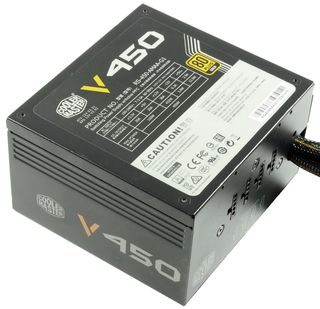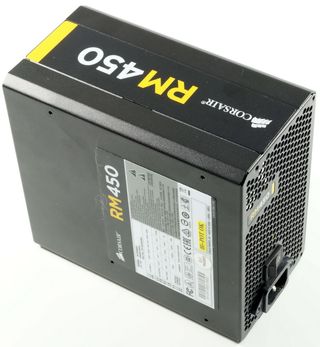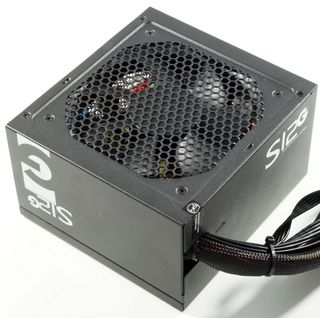Four 80 PLUS Gold Power Supplies Under 450 W, Reviewed
Although high-wattage power supplies get most of the glory, we take our hats off to small, efficient solutions offering more practical output. We take four sub-450 W PSUs and run them through our benchmark suite to see if we can determine a winner.
Efficient, 80 PLUS Gold-Certified PSUs: A Lot Of Good Options
Power supplies in the 450 W range with 80 PLUS Gold certifications are understandably popular. They offer enough power for most PCs, they're obviously efficient, and they aren't incredibly expensive. Even though 450 W sounds small, a good manufacturer will arm its offering with plenty of cables and connectors (enough so that a couple of single-GPU graphics cards are often viable). Modular cables are almost always part of the value proposition as well.
Today's round-up shows that some of the top vendors make similar choices when it comes to pricing and the performance of their power supplies' internal parts. Differences that do exist typically involve the bundled accessories.
Because the companies that chose to submit samples for testing are generally well-respected, it's hard to go wrong with any of these units. Since we can't identify one clear winner, here are our thoughts on each power supply:

Enermax's 430 W Revolution X't has the lowest output rating in our round-up. However, the difference between it and the other three power supplies is small, especially since the Revolution's +12 V rail delivers up to 98% of its theoretical performance in practice.
Strengths include good build quality and lots of connectors. The partly modular cabling facilitates some flexibility. Performance-wise, our measurements turn out unremarkable; they're neither good or bad versus the competition.
If we look at Enermax's cooling solution, you get a constant, but unobtrusive fan noise. Compared to the rest of the field, however, it's the loudest. The components contained within aren't particularly high-end, though most enthusiasts would consider them acceptable.
All things considered, the Revolution X't does its job well. The worst thing we can say about it is that Enermax is on the expensive side in a field filled with strong contenders.

One such contender is Cooler Master's V450S. Fortunately for Enermax, you can't buy the V450S in the U.S. Overseas, where this power supply is available, it represents the semi-modular implementation of Cooler Master's completely modular V family. It shares that line-up's high efficiency, beating the other PSUs in our round-up at each load level. This distinction is particularly striking at low loads.
The V450S also does well when it comes to ripple and noise. The remaining measurements are unremarkable. Cooler Master does cut corners a bit on cable length and connector variety. As we saw from Enermax's Revolution X't, though, there’s nothing to complain about once we open the V450S up and pore over its internals.

If you're looking for a silent PSU, consider Corsair's RM450 instead. Its fan doesn’t even spin most of the time thanks to a well-designed semi-passive design. And even when higher loads necessitate active cooling, the fan is quiet.
The RM450’s build quality is exemplary, and its internals follow suit. You don't get the most modern topology, but since it still achieves 80 PLUS Gold-class efficiency, we can't really complain. But Corsair's RM450 doesn't push past those qualifying marks, and its efficiency drops fast at lower load levels.
One possible explanation could be the fully modular cabling, which is unique among the four power supplies tested today. Combined with long runs and a wide variety of connectors, you at least get the best possible flexibility for cable management.

At first glance, Seasonic's S12G 450 W appears to be this round-up’s wallflower. There's no cable management, the chassis isn't fancy, and the price tag is noticeably low. We know by now not to judge books by their cover though, right?
In reality, the S12G has every right to sport its 80 PLUS logo. Just like the Enermax and Corsair offerings, though, its efficiency does decline a lot faster than the Cooler Master V450S. Still, it doesn't exhibit any weaknesses in our other measurements, behaving well in the ripple and noise benchmarks.
Seasonic doesn't cut any corners with cable length or connector variety. The supply's fan does spin continuously, but it's also really quiet. Open the S12G up and, particularly after paying the lowest price in this round-up, you get your biggest surprise: a modern design with high-quality components and fantastic soldering throughout. Enthusiasts with their own cable management skills and a penchant for good bargains should choose this power supply.
Current page: Efficient, 80 PLUS Gold-Certified PSUs: A Lot Of Good Options
Prev Page Test Configuration, Methodology and ResultsStay on the Cutting Edge
Join the experts who read Tom's Hardware for the inside track on enthusiast PC tech news — and have for over 25 years. We'll send breaking news and in-depth reviews of CPUs, GPUs, AI, maker hardware and more straight to your inbox.
-
iam2thecrowe they did ripple tests......they load tested them....... that's about as much as most readers need to know, that it wont blow up at 100% load and wont damage components with excess ripple. better than some reviews i have read "we hooked it up to a pc and it worked, give gold award..."Reply -
Onus Too bad Rosewill did not submit its Capstone for this roundup.Reply
It would have also been nice to see one of Seasonic's TFX units included.
-
xenol Ripple and line noise tests are the indicators of whether or not a power supply is made with solid parts or made with parts that just do the job and will probably last about a year of nominal use before releasing the magic smoke. If there's a lot of ripple, then the motherboard's house keeping circuitry is going to do a lot of work to keep stable voltages (especially when a difference of even 0.1V matters).Reply
Yes, these are supposedly made by top-tier manufacturers, but just because they have a reputation in the past doesn't mean they have a clean slate the entire way through. -
2Be_or_Not2Be I am just happy that we have some reviews of more reasonable P/S. Most people I know aren't running 1000W+.Reply
"In order to keep prices within reason, we settled on an 80 PLUS Gold rating as sufficient to meet our second demand."
I'm also happy with my 80+ Bronze P/S. Frankly, when you're buying smaller output P/S, I really don't know why anyone would need to get a Gold-rated one. -
Adroid Yea I am really confused by the huge price tags here.Reply
I paid like 70$ for a top of the line 660W seasonic platinum PSU after MIR. Needless to say I was patient and waited for a good deal, but I see high quality 650-750W PSUs for 80$ after MIRs regularly. -
hannibal Well good quality 400W PSU can be better choice than good quality 600W version. If it works within its best efficiency area.Reply -
Adroid Reply13725552 said:Well good quality 400W PSU can be better choice than good quality 600W version. If it works within its best efficiency area.
True, PSUs typically operate most effeciently at 80% load. I build gaming rigs though, so 400W is always too small.
I just expected smaller PSUs to be cheaper, that's all.
-
Drejeck There's a big mistake in considering 400W insufficient for gaming. I have a 770 phantom, a 750ti from kfa2 for physx, an i7 2600K at 4,4ghz, various neons, a load of fans, 4 SSDs, 2 black faex 2TB, an asus xonar d2x, and still I can't reach over 420W of power consumption in torture tests, measured with the highest end APC Smart (865W UPS). I have a Corsair 850W Gold, which is a Seasonic rebrand. And I'm ashamed I went so much overkill with my PSU.Reply
This review feels like useless. There's no ripple testing, whatever the second comment user says. Get some review from Guru3D and you'll see.
Based on words I can't compare with other products on other reviews, so this is quite a fail.
